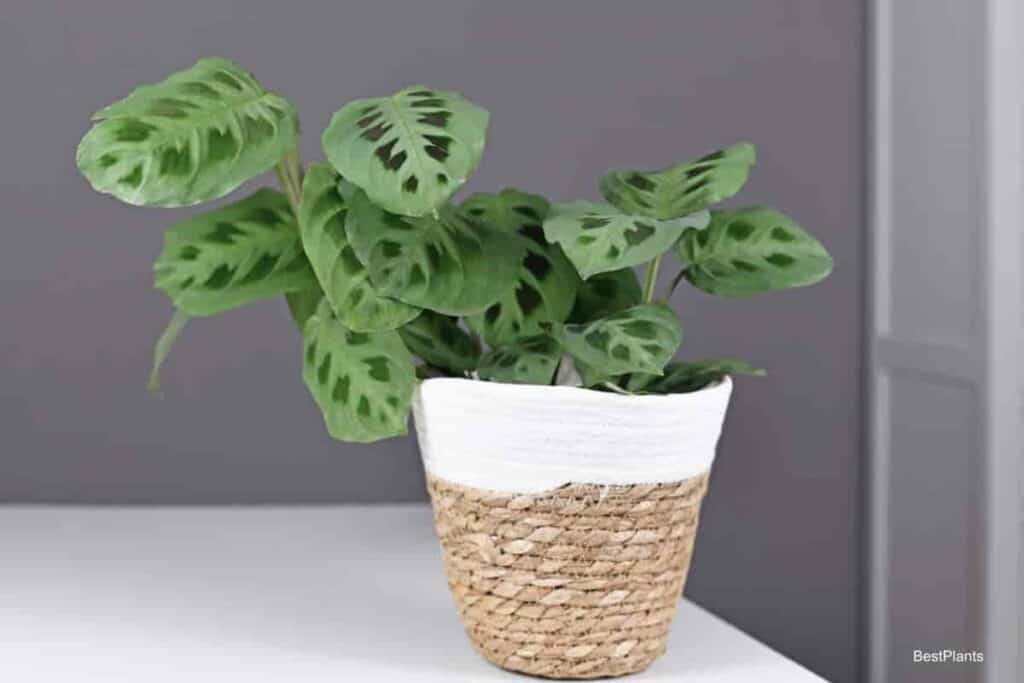When you think of prayer plants, you’re probably either picturing a Maranta or Calathea.
Both come from the Marantaceae family and have a similar appearance and behavior.

One of the most popular prayer plants is the Maranta leuconeura (muh-RAN-tuh loo-koh-NYUR-uh), a herbaceous perennial hailing from Brazil.
This plant has quite a few nicknames, including:
- Cathedral Windows
- Herringbone Plant
- Prayer Plant
- Rabbit Tracks
- Red-Veined Prayer Plant
This prayer plant species is best known for its white veins, where the species earned its name.
However, it has also been the parent to several cultivars with their colorations, such as:
- ‘Erythoneura’ (Red Prayer Plant, AKA Herringbone Plant)
- ‘Kerchoneana’ (Rabbit’s Foot)
- ‘Kim’
- ‘Lemon-Lime’
- ‘Leuconeura’ (Black Prayer Plant)
- ‘Marisela’
- ‘Massangeana’
Maranta leuconeura Care
Size & Growth
M. leuconeura is a fairly short species, reaching a height of between 12 and 15” inches and about the same width.
The mostly green oval to elliptical leaves grow to 5” inches long and have white veins.
The top part of the leaves is covered in various markings, from lines to splotches of color.
Meanwhile, the underside is greyish to purplish green.
New leaves appear as rolled tubes, unfurling as they grow.
The plant gets its name from the adult leaves folding upwards at night as if the plant is praying.
Flowering and Fragrance
While prayer plants can produce small white flowers, it’s rare for them to bloom indoors.
The plant will bloom from May to July when grown outdoors under ideal conditions or in a conservatory.
Light & Temperature
This species of Maranta won’t yell at you for putting it in an office.
It prefers medium to low light conditions and will thrive under fluorescent lighting.
Just be sure it gets some bright, indirect light in the winter and increases the amount of light if the markings dull or the stems become leggy during the growing season.
Avoid direct sunlight, as this will bleach out the markings and may also result in leaf burn.
Being natives of the rainforest, your prayer plant will suffer if not provided with enough humidity.
A pebble tray or humidifier will help increase the ambient temperature.
Alternatively, this plant makes an ideal choice for the bathroom and will also fare well in the kitchen – two rooms where humidity is naturally much higher.
An occasional misting will also help keep your prayer plant happy.
One downside to this species is its intolerance of cold.
It may be grown outdoors in USDA hardiness zones 11 to 12 or indoors in a room where the temperature stays between 65 and 75° degrees Fahrenheit.
The plant’s leaves will begin to suffer damage if the ambient temperature drops below 55° degrees Fahrenheit or goes above 80° degrees Fahrenheit.
Good air circulation is beneficial, but Maranta leuconeura must stay away from drafts.
Watering and Feeding
Your prayer plant is sensitive to lime, so avoid using tap water.
Instead, use room temperature rainwater or distilled water.
When the soil has become dry to the touch, add a little water in the morning.
This way, the plant will be less likely to suffer root rot.
Most decent, balanced houseplant fertilizers will suffice, but make sure to follow the instructions carefully.
Diluted liquid fertilizers tend to work best.
It’s important to pay close attention to your plant to determine the frequency, as too much fertilizer can lead to chemical burns, and too little can stunt growth.
Feed the plant every 2 to 4 weeks during the growing season and cut back in winter when the plant is dormant.
Soil & Transplanting
Just about any quality, well-draining potting mix will work for your prayer plant, although you should avoid cheap brands.
Often, these low-cost soils haven’t been sterilized and may carry fungal spores or dormant pests.
Instead, go with Miracle-Gro or a similar quality brand with a soil pH of 5.5 to 6.0.
Conversely, you may create a potting mix using equal parts soil, aggregate (coarse sand or perlite), and organic matter (peat or compost).
Unlike many plants, your Maranta leuconeura will benefit from being repotted every spring.
This will provide the plant with fresh, well-aerated soil and help to encourage growth.
While most pots would do, the prayer plant has shallow roots and well in flat containers.
When needed, upscale to a pot approximately 2” inches wider.
The plant may also grow hydroponically if desired.
Grooming And Maintenance
While not necessary, pruning your prayer plant in the spring and fall (and sometimes in the summer) will encourage new, fuller growth.
Use sterile shears and always cut just above the leaf node.
If your plant blooms, deadhead the spent (or even living) flowers to help encourage leaf growth.
How To Propagate Prayer Plant
There are two major ways of propagating your leuconeura.
Leaf cuttings are the easiest and most common method.
Place the cuttings in either soil or water.
Meanwhile, a division is a great option if you wish to divide while repotting.
Both methods are handled the same way as most of your other houseplants, making them easy to add to your collection.
Herringbone Plant Pests or Diseases
Although the plant is generally resistant to both bugs and disease, aphids, bug mites, mealybugs, and spider mites can all become a nuisance.
Root rot is the biggest danger, followed by the cucumber mosaic virus. Leaf spot and fungal infections can also occur but are rare when the plant is properly cared for.
This species is non-toxic to humans and pets.
Maranta leuconeura Uses
This particular prayer plant is perfect for hanging baskets and makes for a great shade-loving ground cover in compatible zones.
Its evergreen leaves also make it a prime choice for use as a winter feature.